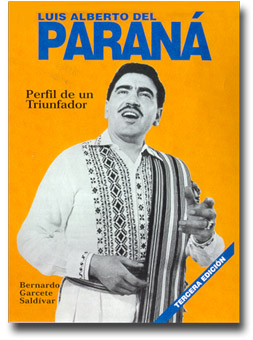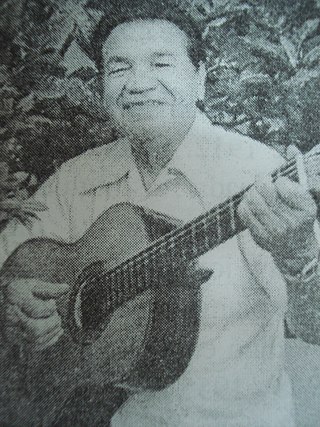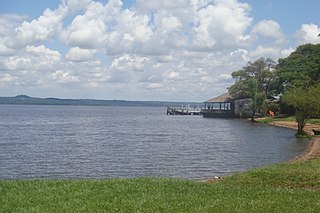Related Research Articles
The folkloric traditional music of Paraguay is the Paraguayan polka and the Guarania. The Paraguayan polka comes from polka of Czech origin; that was danced for the first time in Asunción, on November 27, 1858. The guarania was created by the Paraguayan musician José Asunción Flores, in January 1925, after experiencing different arrangements with the old Paraguayan musical theme "Ma'erãpa reikuaase". Paraguay also has classical music and popular music consisting of rock and jazz music. The folk music uses a range of different instruments some of which include the Spanish guitar and the European harp.

Luque is a city in Central Department of Paraguay, part of the Gran Asunción metropolitan area. Both 1635 and 1750 have been recorded as dates of its founding. It was temporarily the capital of Paraguay in 1868 during the Paraguayan War before relocation to San Estanislao. It is located at around 25°16′12″S57°29′14″W. Luque is one of the most important cities in the country. The city counts as home of Paraguay's main international airport, Silvio Pettirossi International Airport and the Ñu Guasú Park, which is where the Paraguayan Olympic Committee is also located. The continental governing body of association football in South America, CONMEBOL, has its headquarters approximately 3 minutes from the Airport, consisting of the South American Football Museum and walking distance from the Bourbon CONMEBOL Asunción Convention Hotel. When it existed, ARPA – Aerolíneas Paraguayas had its headquarters in the ARPA Terminal on the grounds of the airport. It is a center of production of Guitars and Paraguayan harps as well as Filigranas, gold and silver filigree jewelry including the seven-band ring Carretón de Siete Ramales. On 27 January 2016, Paraguayan Newspaper La Nación had reported that Carlos Echeverría Estigarribia, the elected intendent of the city of Luque, states his intention of wanting Luque to be one of the most important cities.

Football is by far the most popular sport in Paraguay. Paraguay's national team has played at eight FIFA World Cup competitions and has won two Copa América tournaments. Olimpia Asunción is the country's most successful club in domestic and international competitions. Paraguay's football leagues are divided into four divisions. In 2020, Paraguay's top-tier was ranked 8th in the world by the IFFHS.

Luis Alberto del Paraná was a Paraguayan singer and guitarist. During the fifties, sixties and early seventies, he traveled extensively around the globe with his group Los Paraguayos, popularizing Paraguayan music. He is the best-selling Paraguayan musician ever.

Agustín Pío Barboza was a Paraguayan singer and composer.
Félix Pérez Cardozo was a Paraguayan harpist.
Carlos Lara Bareiro was a Paraguayan classical musician, composer, and conductor. He was born on the March 6, 1914 to Juan Carlos Lara Castro and Lorenza Bareiro in Capiatá, Paraguay. He inherited the aptitude and vocation for music from his father and learned the basics of this art which he would then dominate.
Eladio Martínez was born in Paraguarí, Paraguay, on May 19, 1912, son of Lorenzo Martínez and Nicolasa Benítez. He belonged to a family of musicians. His father was a bandleader of a group formed entirely by his relatives in Villarrica.

The Ypacaraí Festival has been held in the city of Ypacaraí, Paraguay, since 1971, between August and September. It is a folklore festival organized with great emphasis on all kinds of cultural manifestations.
Oscar Nelson Safuán was a Lebanese-Paraguayan composer. He was the creator and developer of the music genre called Avanzada.
Elio Ramon Gonzalez, better known as Neneco Norton, was a Paraguayan musician, composer and orchestra director. Norton was born in 1923 in Asuncion, Paraguay on December 8, the day of the festival of the Virgin of Caacupé, an important date for Paraguayans. His parents were Apolonio Benitez and Hermelinda Gonzalez.
José Bragato was an Italian-born Argentine cellist, composer, conductor, arranger and musical archivist who, in his early career, was principal cellist in the Colón Theatre orchestra in Buenos Aires, Argentina. Apart from his involvement in classical music he also performed for many years in a number of Ástor Piazzolla's Nuevo tango ensembles where his cello solos, which had never before featured in tango, put him in the vanguard of Nuevo tango from its birth in the 1950s. Since then he has done numerous and varied arrangements of Piazzolla's compositions.
Sport in Paraguay is an important part of national culture. Association football is the most popular sport, while basketball is also very popular. Other sports such as padel, volleyball, futsal, swimming and tennis are popular as well. Other Paraguayan sports and pastimes are rugby union, chess, motorsport, golf and rowing.
Luis Martínez Griñán, better known as Lilí Martínez, was a Cuban pianist, arranger and composer specializing in the son montuno style. He played in the Conjunto de Arsenio Rodríguez and Conjunto Chappottín. Together with Rubén González and Peruchín, he is said to have "forged the style of modem Cuban piano playing in the 1940s".
María Cristina Gómez Rabito de González was a 20th-century harpist whose Paraguayan harp music won national and international recognition.

Lilian Graciela Samaniego González is a Paraguayan pharmaceutical chemist and politician of the Colorado Party. She has been a member of the Senate of Paraguay since 2004.

María Odulia Nicola Ruotti, also known as Chinita de Nicola, was a singer and composer from Paraguay who was blind from a young age.
María Concepción Leyes de Chaves was a Paraguayan writer, playwright, journalist and lecturer.

General elections were held in Paraguay on 30 April 2023 to elect the president, vice president, National Congress, and departmental governors. The incumbent president Mario Abdo Benítez and vice president Hugo Velázquez Moreno, both of the Colorado Party, were ineligible for re-election.
Pedro Javier Godoy Agüero is a Paraguayan footballer who plays as a forward.
References
- 1 2 3 4 5 6 7 8 Luis Szaran: Diccionario de la Música en el Paraguay. Edición de la Jesuitenmission Nürnberg, Alemania, 2007. Edición digital: http://www.portalguarani.com/1475_enrique_samaniego.html. Retrieved April 8, 2018.
- 1 2 3 4 5 6 7 8 9 10 11 12 13 14 15 16 Aida Lara, conductora radial: Enrique Samaniego, http://www.musicaparaguaya.org.py/enrique_samaniego.htm. Retrieved April 8, 2018.
- 1 2 3 4 ABC Digital: Compositor y Docente de Numerosos Instrumentistas | Murió ayer el arpista Enrique Samaniego, http://www.abc.com.py/espectaculos/murio-ayer-el-arpista-enrique-samaniego-820634.html, 27 de Marzo de 2005. Retrieved April 8, 2018.
- ↑ Sistema Nacional de Información Cultural del Paraguay, Legislación y Derechos Culturales, Ley 2.158 "Que concede pensión graciable al Señor Rigoberto Samaniego González", http://sicpy.gov.py/generales/?470. Retrieved April 8, 2018.
- ↑ Sistema de Informacion Legislative: Ficha Técnica de la Sesión, Camara de Senadores – Sesión: Ordinaria Nro. 35, Jueves 29 de Marzo de 2007, 7. Proyecto de Ley: "Que concede Pensión Graciable a la Señora Arminda Ocampos de Samaniego, viuda del Folklorista Paraguayo Don Rigoberto Samaniego González", presentado por el Senador Juan Carlos Ramírez Montalbetti, http://silpy.congreso.gov.py/sesion/1011. Retrieved April 8, 2018.
- ↑ Discogs: Enrique Samaniego, https://www.discogs.com/artist/1876880-Enrique-Samaniego. Retrieved April 8, 2018.